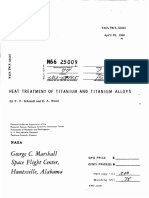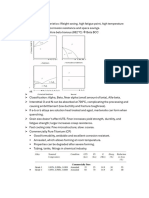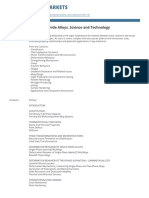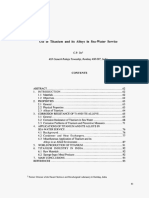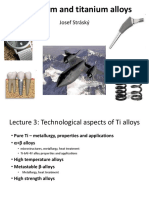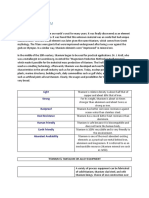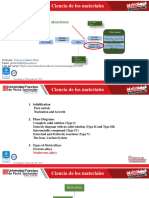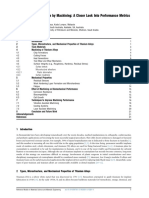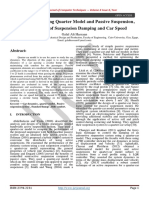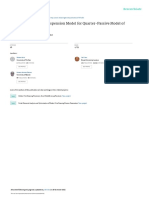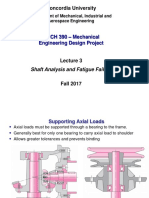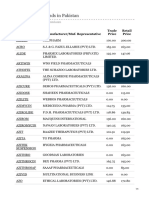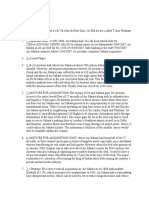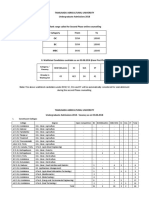Contents
Preface .............................................................................
1.
Introduction ..............................................................
1.1
Purpose of the Book .....................................................
1.2
History of Titanium .......................................................
1.3
Emergence as Commercial Material ...........................
1.4
Titanium Industry Status ..............................................
1.5
Traditional and Emerging Applications ........................
Fundamental Aspects .............................................
13
2.1
Basic Properties ...........................................................
13
2.2
Crystal Structure ..........................................................
14
2.3
Elastic Properties .........................................................
14
2.4
Deformation Modes ......................................................
17
2.4.1
Slip Modes ...................................................
17
2.4.2
Deformation Twinning ..................................
20
2.5
Phase Diagrams ...........................................................
21
2.6
Phase Transformations ................................................
27
2.6.1
Martensite Transformation ...........................
27
2.6.2
Nucleation and Diffusional Growth ...............
30
Alloy Classification .......................................................
31
2.
2.7
This page has been reformatted by Knovel to provide easier navigation.
vii
�viii
Contents
2.8
Basic Hardening Mechanisms .....................................
34
2.8.1
Hardening of the Alpha Phase .....................
35
2.8.2
Hardening of the Beta Phase .......................
36
Basic Physical and Chemical Properties .....................
40
2.9.1
Diffusion ......................................................
43
2.9.2
Corrosion Behavior ......................................
45
2.9.3
Oxidation .....................................................
48
Technological Aspects ............................................
51
3.1
Sponge Production .......................................................
51
3.2
Melting ..........................................................................
57
3.2.1
Vacuum Arc Remelting (VAR) ......................
58
3.2.2
Cold Hearth Melting (CHM) ..........................
62
3.2.3
Melt Related Defects ...................................
66
3.3
Primary Processing ......................................................
70
3.4
Shaping into Components ...........................................
77
3.4.1
Forging ........................................................
77
3.4.2
Ring Rolling .................................................
81
3.4.3
Metal Removal (Machining) .........................
83
Near Net Shape Processes .........................................
84
3.5.1
Casting ........................................................
85
3.5.2
Powder Metallurgy .......................................
89
3.5.3
Laser Forming .............................................
93
3.5.4
Conventional Sheet Forming .......................
95
3.5.5
Superplastic Forming and Diffusion
Bonding .......................................................
97
2.9
3.
3.5
3.6
Conventional Joining Methods ..................................... 102
3.6.1
Fusion Welding ............................................ 102
3.6.2
Friction Welding ........................................... 109
This page has been reformatted by Knovel to provide easier navigation.
�Contents
3.7
3.8
3.9
4.
ix
Surface Treatment ....................................................... 113
3.7.1
Shot Peening ............................................... 114
3.7.2
Laser Shock Processing .............................. 118
3.7.3
Chemical Milling .......................................... 121
3.7.4
Electrochemical Machining .......................... 123
Inspection Methods ...................................................... 123
3.8.1
Ultrasonic Inspection ................................... 124
3.8.2
Radiographic Inspection .............................. 129
3.8.3
Surface Etching Inspection .......................... 129
3.8.4
Eddy Current Inspection .............................. 132
3.8.5
Dye Penetrant Inspection ............................. 133
3.8.6
Surface Replication ...................................... 134
Characterization Methods ............................................ 134
3.9.1
Light Microscopy .......................................... 135
3.9.2
Electron Microscopy .................................... 139
3.9.2.1 Transmission Electron
Microscopy ....................................... 139
3.9.2.2 Scanning Electron Microscopy ......... 143
3.9.3
X-Ray Diffraction ......................................... 146
3.9.4
Mechanical Testing ...................................... 147
Commercially Pure (CP) Titanium and Alpha
Alloys ........................................................................ 149
4.1
Processing and Microstructure .................................... 151
4.1.1
Material Processing ..................................... 151
4.1.2
Processing into Components ....................... 157
4.2
Microstructure, Composition, and
Properties ..................................................................... 159
4.3
Properties and Applications ......................................... 172
This page has been reformatted by Knovel to provide easier navigation.
Contents
5.
Alpha + Beta Alloys ................................................. 177
5.1
5.2
5.3
6.
7.
Processing and Microstructure .................................... 177
5.1.1
Fully Lamellar Microstructures ..................... 177
5.1.2
Bi-Modal Microstructures ............................. 182
5.1.3
Fully Equiaxed Microstructures .................... 186
Microstructure and Mechanical Properties .................. 190
5.2.1
Fully Lamellar Microstructures ..................... 192
5.2.2
Bi-Modal Microstructures ............................. 201
5.2.3
Fully Equiaxed Microstructures .................... 208
5.2.4
Effect of Aging and Oxygen Content ............ 212
5.2.5
Effect of Secondary Alpha in Beta
Phase .......................................................... 217
5.2.6
Effect of Crystallographic Texture ................ 220
Properties and Application ........................................... 224
High Temperature Alloys ........................................ 233
6.1
Processing and Microstructure .................................... 234
6.2
Microstructure and Mechanical Properties .................. 235
6.3
Properties and Application ........................................... 244
Beta Alloys ............................................................... 247
7.1
7.2
Processing and Microstructure .................................... 247
7.1.1
Beta Annealed Microstructures .................... 248
7.1.2
Beta Processed Microstructures .................. 254
7.1.3
Through-Transus Processed
Microstructures ............................................ 256
7.1.4
Bi-Modal Microstructures ............................. 259
Microstructure and Mechanical Properties .................. 261
7.2.1
Effect of Processing Route .......................... 263
7.2.1.1 Tensile Properties ............................. 263
This page has been reformatted by Knovel to provide easier navigation.
�Contents
xi
7.2.1.2 Fatigue Properties ............................ 266
7.2.1.3 Fracture Toughness ......................... 272
7.3
8.
Effect of Age-Hardening .............................. 274
7.2.3
Effect of Beta Grain Size ............................. 279
Properties and Application ........................................... 281
Titanium Based Intermetallics ................................ 289
8.1
Alloying and Microstructure .......................................... 290
8.2
Microstructure and Properties ...................................... 300
8.3
9.
7.2.2
8.2.1
Alpha 2 and Orthorhombic
Alloys ........................................................... 301
8.2.2
Gamma Alloys ............................................. 306
Applications .................................................................. 308
Titanium Matrix Composites ................................... 313
9.1
Processing .................................................................... 313
9.2
Properties ..................................................................... 318
9.3
9.2.1
Tensile Properties ........................................ 318
9.2.2
Fatigue Properties ....................................... 321
9.2.3
Creep Properties ......................................... 323
Applications .................................................................. 325
10. Special Properties and Applications of
Titanium .................................................................... 329
10.1 Superconductivity ......................................................... 329
10.2 Burn Resistance ........................................................... 334
10.2.1 Phenomenology of Titanium Fires ............... 335
10.2.2 Alloy Selection for Fire Risk
Mitigation ..................................................... 336
10.3 Hydrogen Storage ........................................................ 337
This page has been reformatted by Knovel to provide easier navigation.
�xii
Contents
10.4 Shape Memory Effect .................................................. 339
10.4.1 Phenomenology of the Shape Memory
Effect ........................................................... 339
10.4.2 Applications of Shape Memory Alloys .......... 343
10.5 Biomedical Applications ............................................... 345
10.6 Automotive Applications ............................................... 349
10.7 Sports Related Applications ......................................... 351
10.8 Appearance Related Applications ............................... 354
References ...................................................................... 357
Index ................................................................................ 369
This page has been reformatted by Knovel to provide easier navigation.


